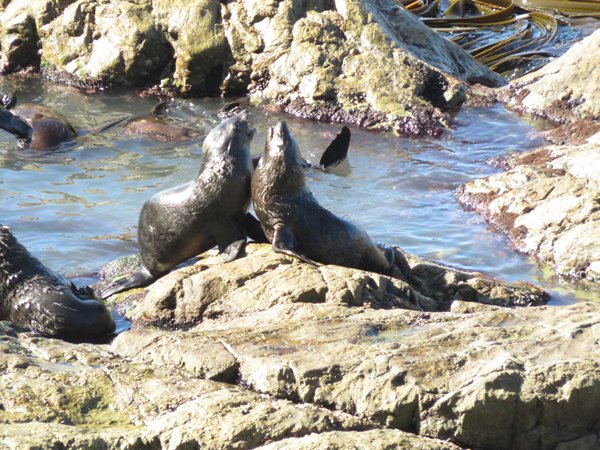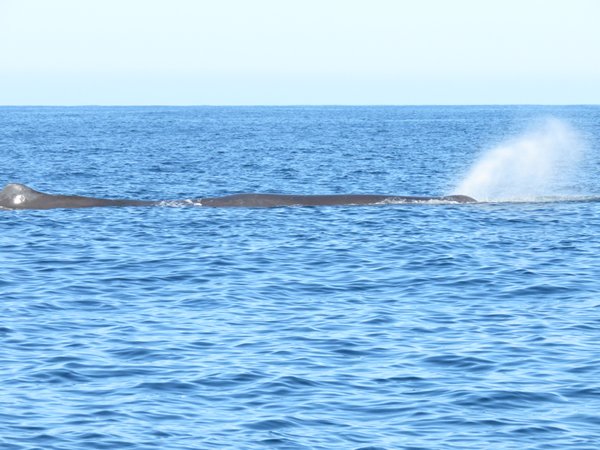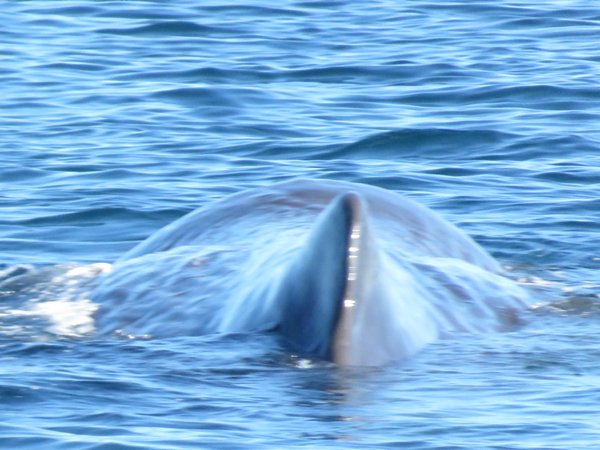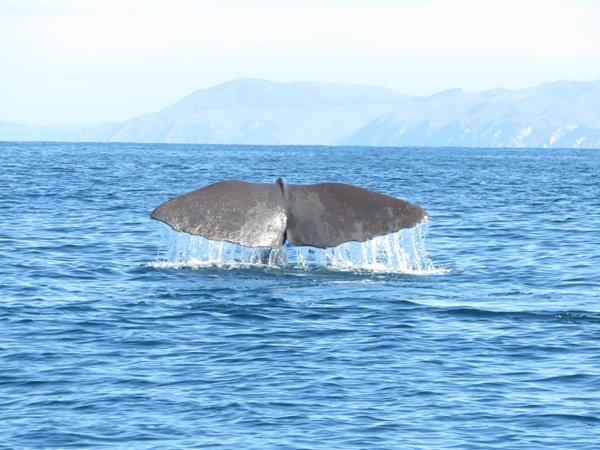Kiakoura and Whale watching 42:40° S: 173:68° E

SV Jenny
Alan Franklin/Lynne Gane
Tue 12 Apr 2016 09:20
Dear Family and Friends,
5th April 2016
Whale watching was definitely on my list of must do activities! And Kiakoura is the place to do this with a designated marine sanctuary around the coast, and the reason for this is the deep underwater canyon just off shore. The continental shelf ends abruptly and the coast is in the current bringing plankton rich waters from the Antarctic. The geography of the seabed causes the rich waters to rise closer to the surface and that encourages the male whales to feed there much of the year. Sperm whales are particularly noted here but many others are visitors, just less often. And where there is food there are fish and dolphins, Dusty and Hector dolphins to give them their names, the last an endangered species. Hector dolphins are smaller with a rounded fin and although shy, were playing happily just by our tour boat for a really good view. Of course the whole trip is based on sighting a sperm whale which we did pretty quickly thanks to a previous sight and communications with the light aircraft that are also looking them. It is difficult to gauge the scale of their size as they lie on the surface, just showing their fin and a little of their girth above the water, filling their lungs for around 8-10 minutes before diving for 30-40 minutes. But we got that magic tail shot as the whales dived!
The boat was surprisingly smooth ride and we were blessed with a lovely day for the trip. We even got to see the NZ fur seals and an Albatross so that was fantastic if expensive, (again).
The coast driving down to Kiakoura and beyond south, is very beautiful. The road clings to the rocky coast, following the same track as the railway for much of the time. We came across a fur seal colony just north of Kiakoura and best of all, a short walk to a waterfall close by where the young pups go up stream to the bottom of the waterfall to play in the pool, in safety. That was magical and FREE!
6th April 2016
Christchurch is an hour or so further south. Most of us will be familiar with the city because of the earthquake in 2011, unforgettable scenes of devastation as over 70% of the city was destroyed and remains a building site. The satnav got her knickers in a twist as numerous times we could not go on the directed route! Although the city museum remains intact, much is not, the botanical gardens are interesting, the old tram an historic ride even if the route is truncated and the buildings gone. Rising from the ruins so to speak, Christchurch cathedral in cardboard is quite something, as are the container as in shipping, retail parks! The problem for the city lies in its location on a major fault between the tectonic plate that NZ lies upon and the one to the east of the islands, an active subduction zone where the plates move. So it must be a dilemma for city planners, build in the same area, with earthquake resistant building or move elsewhere. They show no signs of doing the latter.
7-8th April 2016
Back in the bus, our changed bus, as the company we hired from has given us probably their worst bus, for our 97 days of hire, and we were not happy to find that it needed a WOF, (warrant of fitness = MOT) before the hire ended. And when we arrived with prior notice, the van was not ready!!!! We managed to get an upgraded van as a result, and a free satnav and a few extras so all was not lost but we are not impressed with the firm!
Anyway back to the journey, much of the eastern plains are given over to agriculture, cattle, sheep, some arable and a lot of vines. Rolling hills and flat plains until the mountains edge, are broken by frequent fir tree barriers which speak of the prevailing winds. Much of the eastern side up to the mountains is in the grip of a dry spell, the worry has been both for the poorer pasture for livestock and the effect of the rain splitting the grapes just before harvest. Clearly there is no right weather, the word among the backpackers in the hostels was of vineyard owners pulling out the stops to get the harvest in.
The arid landscape continued up into the foothills and mountains of the Southern Alps. Upper pastures, given over to sheep and occasional cattle, were mostly browned grass and tussocks. The scenery, rocky, limestone erosion, deep river gorges, peaks and scree, trees sheltering in the ravines and valleys away from the worst of the weather. Signs proclaim the road open, clearly sometimes it is not.
We chose to take the Arthur's pass, by the impressive waterfall, through the mountains to Hokitika on the west coast. As soon as we had crested the pass, the scenery changed completely, we had entered the wet side of the watershed with lush forest and lower green pastures. The coast lived up to its name of having 200 days of rain, 5m of rainfall at the coast and much much more in the mountains. the following day was wet, the town hard to get enthusiastic about! Apart from the tourist centre, it seemed a quiet town. But digging a little we found a few gems, sorry terrible pun. The area is noted for finding jade or pounama in Maori, on the beach and with a little help from the jade jewellery producers, we went prospecting on the beach. No doubt they felt safe in their knowledge that jade is more difficult to find than you might imagine. Many stones appear to be green, you have to look out for the ones that feel soapy smooth, cool to the touch, heavy for their size and when wet, do not dry quickly, easy ..... Having picked many stones from the beach, almost all of them where identified as 'leaveit' stones! The chaps at the jade workshop did say that jade finds you and the only piece I found, I chose because it had a nice shape! So Josh has these to turn into something when he gets to college.
The other remarkable thing happened when we saw a sign for ruby rock and went into a shop that looked almost vacant. a lovely old dutch gentleman, 80 years old he told us, told us his story. He had been a amateur prospector with a passion for gemstones and the skill to cut them, prospecting for minerals in Australia, where I think the remains of his stock came from. However at some point he had come to NZ with his family and found a stone subsequently called goodelite, a matrix of ruby and sapphire crystals in a matrix of green minerals, not a crystalline structure as we know it but unique, only found in this part of the world and officially recognized by the institute of Petrology as a new gem stone. he insisted on showing us the news piece on his find, circa 1996, and to boot we got his life history! I can only imagine he was lonely since his wife had died some five years ago, imagine this, he gave us a couple of free gemstones, how kind and Josh had some raw samples of his precious discovery to show his course tutors. All very unexpected and amazing.
All our best,
Lynne, Alan and Josh






